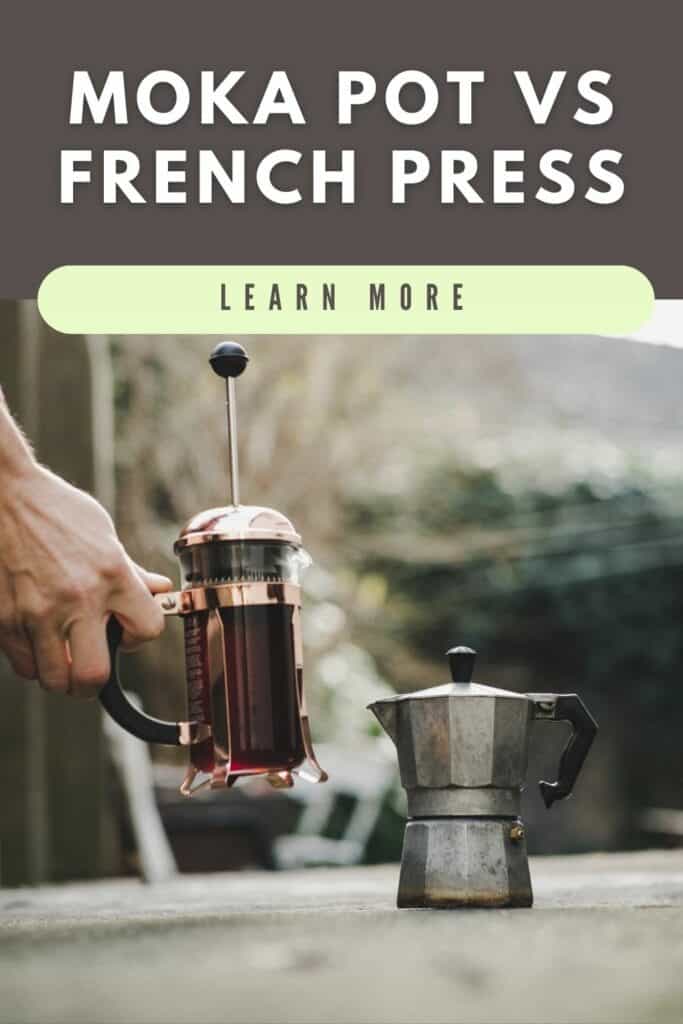When it comes to home brewing methods, the French press and Moka pot stand out as classics. Tried, tested, very affordable, there’s sure to be at least one of these in every kitchen cupboard.
So how do the two compare? We’ll take a look at the Moka pot vs French press and see which comes out on top for factors like ease of use and the quality of the brew.
French Press
The French press is one of the most classic home coffee makers, based on a very simple immersion brewing technique. At their most basic, French presses consist of a glass carafe with a metal plunger. The grounds are steeped in hot water until the ideal extraction has been achieved, then the plunger is depressed to filter out the grounds before pouring. With no paper filter used, the resulting brew is rich with natural oils and flavors.
Pros
-
Creates a rich, full-bodied coffee
- Easy to brew for a crowd
- Hands-off brewing process
Cons
-
Risk of over-extraction
- Messy cleanup
Moka Pot
Just like the French press, the Moka pot has a long history of home use. Developed in Italy in 1933, it quickly gained the nickname of the stovetop espresso maker. Though it doesn’t create a true espresso, it uses the same extraction method as an espresso machine.
When the pot is placed on the stove, water is heated in the bottom chamber. The pressure created forces it up through the coffee grounds and into the top of the pot. Though it only reaches 1.5 bars of pressure, it makes a strong, concentrated coffee, and even the occasional crema.
Pros
-
Creates a strong espresso-like brew
- More forgiving with grind sizes
- Great for camping
Cons
-
Risk of burning the coffee
- More involved cleaning
Moka Pot vs French Press: The Features Compared
The quality of the coffee is going to be one of the biggest factors to consider when buying a coffee maker, but not the only one. You need also need to think about how you plan to use it, and what kind of effort is involved. Here’s how the French press vs Moka pot stack up.
Ease of use
Using a French press coffee maker is about as simple as it gets. Well on paper anyway. You add coarsely ground coffee and hot water to the chamber, and let it sit to brew. This process will get you a pretty decent cup of coffee, but you might need to experiment with the variables to perfectly match your taste.
It’s recommended you stick with a coarse grind, but you can experiment with things like the water to coffee ratio, blooming the coffee grounds, and the extraction time. It might sound complicated if you’re new to these things, but once you find what you like, it’s easy to replicate your recipe time and time again.
It’s not difficult when it comes to the Moka pot, but you have less control over the brew. The amount of coffee you make here will be determined by the size of your Moka pot, so you can’t play around too much with ratios. Once the pot is on the heat, the process is pretty much out of your hands.
You can use hot water to kickstart the process, but the extraction time will depend on how quickly your stove heats up. The pot needs to be removed from the heat as soon as it’s done, or you’ll end up with burnt-tasting coffee.
The one good thing about using the Moka pot is that it can be quite forgiving of grind size, so if you find yourself with only pre-ground coffee to hand, you can still use this method.
Brew time
We’re going to assume you have your coffee freshly ground and ready to go for both of these methods. For the French press, you’ll need time to boil your water, then the time for steeping. We suggest starting with 4 minutes, but it’s one of the variables you can adjust when experimenting with your brew.
The time from bean to cup with a Moka pot can vary a little, depending on the time it takes your stove to heat up. Some people like to preheat the water to reduce the pot’s time on the stove, which prevents any metallic flavors from developing (1). But in this case, you’ll need to factor in extra time for boiling the kettle. Either way, your total time spent will run to about 5 minutes.
Portability
One of the great things about using a manual brewer is that you’re no longer confined to the power outlets in your kitchen. But does that necessarily make these coffee makers portable?
The French press might be reasonably small and lightweight, but having a glass beaker makes it too fragile for throwing in your backpack. You’re also going to need a separate source of hot water. If you want to take one of these on the road, you’ll need a model that’s been specifically designed for that purpose.
If you’re looking at a manual brewer to take camping, check out our guide to the French press vs AeroPress.
A Moka pot tends to be a little more compact–as a “cup” here is just 2 ounces. The metal body does add weight, but it also adds sturdiness that makes it easier to transport. But the biggest benefit with a Moka is that you don’t need a separate kettle. The pot can be placed directly over a campfire or camping stove, so long as you don’t mind it getting a little blackened.
Clean up
If enjoying your morning coffee is one of the best moments of the day, the clean-up afterward is certainly not. So when choosing a coffee maker, you’re going to want to make your life as easy as possible.
The worst part of cleaning a French press is dealing with the grounds. Unlike with other brewing methods, you’re not left with a neat, dry puck. If you don’t want to add a lot of liquid to your trash bin, you’ll need to pour the wet grounds through a strainer before you toss them. Do not pour your French press grounds down the sink. But once that’s out of the way, you just need to was the plunger and carafe with warm, soapy water. Many brands of French press can also go directly into the dishwasher (2).
Whether your Moka pot is stainless steel or aluminum, you should avoid putting it in the dishwasher or using abrasive sponges.
…over time the coffee’s oils will season the Moka pot, which makes the coffee taste better, so you don’t want to scrub it so hard that you remove that thin oily layer.
Daniel Knight, Bialetti
After every brew, you’ll need to empty the grounds, disassemble the pot, and rinse each part with warm water. You’ll also need to descale the pot a couple of times a year–more often if you live in a hard water area (3).
The end product
The French press brews by immersion, which means that the coffee is extracted by prolonged contact with hot water. All of the flavors and natural oils from the beans are released into the coffee, creating a rich, full-bodied brew. Some people may find the mouthfeel a little too full, but it’s what French press fans love about it. Just be sure to avoid the last drops from the pot or you’ll wind up with a whole lot of sediment.
If you’re looking for an espresso-style coffee without the expensive machine, the Moka pot is hands-down your best option. The punchy, concentrated brew from a stovetop espresso maker is a great base for milk drinks like lattes or topped up with hot water for an Americano. Stovetop espresso coffee does get a bad reputation for having a burnt taste, but this is usually just a problem with leaving the pot on the stove too long (4).
The Verdict: French Press vs Stovetop Espresso
As you can see, there are many differences between these two brewing methods that make them suitable for different situations. But at the end of the day, it’s probably going to be the taste that sways your decision, so it’s just a matter of what kind of coffee you like to drink.
Use a French press if:
- You want to taste more of the beans’ natural oils
- You’re brewing for a crowd
- You want fewer parts to clean
Use a Moka pot if:
- You want coffee with punch
- You’re going camping
- You’re using pre-ground coffee
FAQs
The best Moka pot for you will depend on the type of stove you have and your budget. We like the Bialetti Express for its classic Italian vibes, but you can see more of the best stovetop espresso makers here.
Yes, you can make cold brew with a French press. Simply add cold water and coarse ground coffee to your French press. Leave to sit at room temperature for 12 hours before filtering and serving.
There are more than 18 different methods of brewing coffee, but we can group them into four main categories: immersion, pressure, filtration, and boiling.
- How to make stovetop coffee. Pact Coffee. (n.d.). Retrieved from https://www.pactcoffee.com/brew-guides/stovetop.
- BODUM® – FAQ. Bodum. (n.d.). Retrieved from https://www.bodum.com/us/en/faq.
- Oden, G. (n.d.). The quick guide To Moka Pot safety and cleaning. JavaPresse Coffee Company. Retrieved from https://www.javapresse.com/blogs/stovetop-brewing/moka-pot-safety-and-cleaning.

Coffee expert and industry insider, I’ve dedicated years to mastering the art and science of coffee making. From scrutinizing particle fineness to evaluating burr shapes, I delve into the minutiae that elevate coffee from good to exceptional. Whether it’s a complex pour-over or a robust espresso, my insights cater to those who don’t just drink coffee, but experience it.



